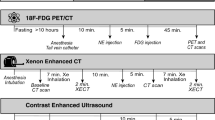Abstract
Brown adipose tissue shows accumulation of FDG in normal fat tissue on PET/MR imaging that can be confusing to the inexperienced reader. Comparison of the fused PET/MR images with non-fused MR images helps differentiate brown fat from true lesions.
Access provided by CONRICYT-eBooks. Download chapter PDF
Similar content being viewed by others
Keywords
History
A 14-year-old male presents for restaging Hodgkin’s lymphoma (Fig. 97.1).
Diagnosis
Brown adipose tissue
Findings
-
Intense hypermetabolic activity corresponding to fat within the lateral aspects of the neck (thin arrows). Milder FDG uptake is seen in the fat of the central compartment (curved arrows).
-
Small benign lymph nodes are seen in the neck on the STIR but without corresponding FDG uptake (arrowheads).
-
Areas of increased FDG uptake have no abnormalities on the STIR or T2 images.
Discussion
One of the many pitfalls of PET FDG imaging is radiotracer accumulation in various organs secondary to physiological or non-neoplastic processes. FDG uptake in brown adipose tissue (BAT) is one such pitfall and its presence can lead to reporting of false-positive findings or obscuration of true neoplastic lesions in the inexperienced reader.
Adipose tissues in humans are of two types, brown adipose tissue and white adipose tissue . White adipose tissue serves as energy storage organ and for thermal insulation. On the other hand, BAT plays a role when there is need for extra body heat such as in neonates, during entry into a febrile state, and non-shivering thermogenesis. Similarly, when placed in cold waiting rooms or PET/MRI scanner rooms, BAT is activated in some patients. Since BAT utilizes glucose and fatty acids for thermogenesis, a patient with FDG in their circulation will demonstrate FDG uptake in BAT.
The most common locations for BAT are the neck, mediastinum, supraclavicular, axillary, and paravertebral regions. Less commonly, FDG uptake in BAT is seen in the paraaortic, peridiaphragmatic, and perinephric regions. There are many factors that affect FDG accumulation in BAT. These include higher incidence and uptake in younger patients, more common in females, lower body mass index, and colder ambient temperature. Brown fat FDG uptake is observed more commonly in breast cancer and sarcoma patients and less commonly in patients with lymphoma and lung cancer. Comparison of the fused PET/MR images with non-fused MR images helps differentiate brown adipose tissue from true lesions. In particular, this is important in the distinction of FDG abnormal uptake in the lymph nodes from surrounding BAT FDG activity . Appearance of BAT on MR is exactly the same as white adipose tissue elsewhere in the body. When the signal intensity on MR images is not clear, fat-suppressed images may be obtained to demonstrate absence or presence of a true lesion.
Suggested Reading
Cronin CG, Prakash P, Daniels GH, Boland GW, Kalra MK, Halpern EF, et al. Brown fat at PET/CT: correlation with patient characteristics. Radiology. 2012;263(3):836–42.
Townsend KL, Tseng YH. Brown fat fuel utilization and thermogenesis. Trends Endocrinol Metab. 2014;25(4):168–77.
Author information
Authors and Affiliations
Corresponding author
Rights and permissions
Copyright information
© 2018 Springer International Publishing AG
About this chapter
Cite this chapter
Gupta, A. (2018). Brown Adipose Tissue. In: PET/MR Imaging . Springer, Cham. https://doi.org/10.1007/978-3-319-65106-4_97
Download citation
DOI: https://doi.org/10.1007/978-3-319-65106-4_97
Published:
Publisher Name: Springer, Cham
Print ISBN: 978-3-319-65105-7
Online ISBN: 978-3-319-65106-4
eBook Packages: MedicineMedicine (R0)





